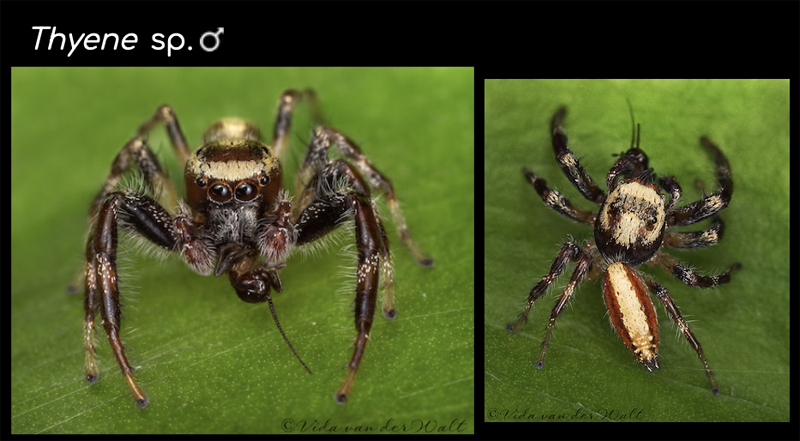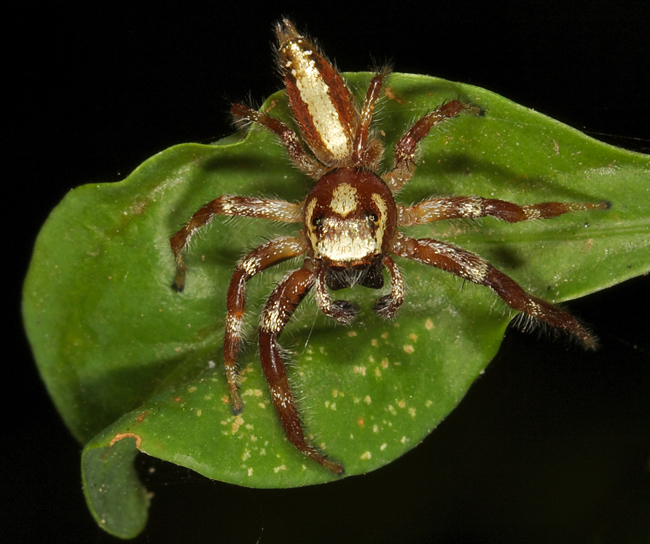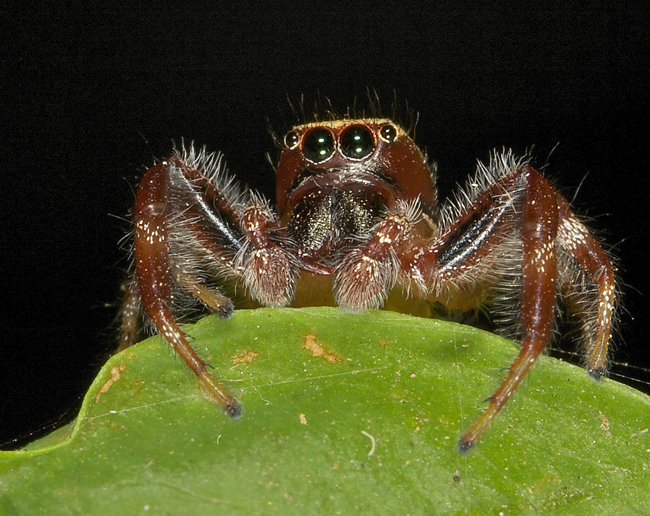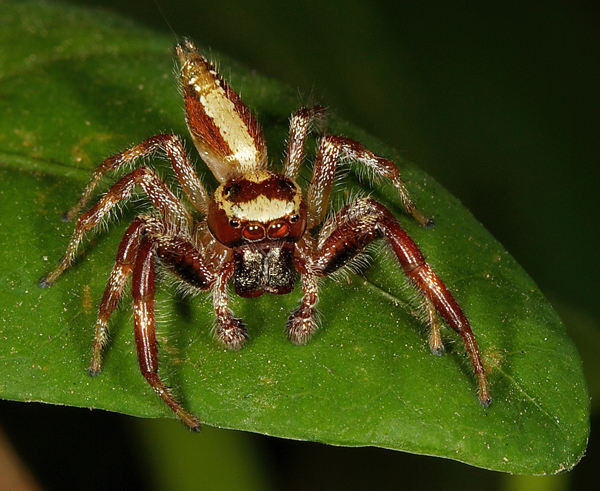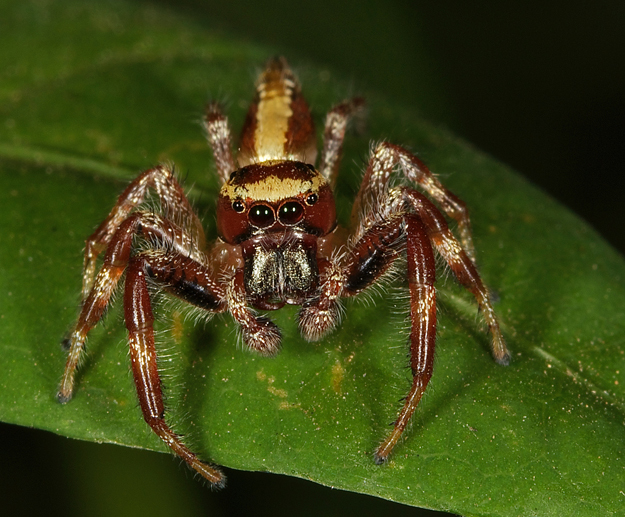Re Thyene
Boths are young males of Thyene and only the adult males are really blackish dark, I have been looking also into T. ogdeni and T. leighi and they do look more or less all the same as youngsters.
Can you maybe check if you have sen these young ones together with another Thyene from the same spot.
Otherwise we make them Thyene sp. possibly T. coccineovittata, ogdeni, or leighi
Are the two you posted from the same year and same spot?
Insect or Invertebrates Identification - DONE
Moderator: Klipspringer
-
Klipspringer
- Global Moderator
- Posts: 5858
- Joined: Sat Sep 14, 2013 12:34 pm
- Country: Germany
- Contact:
- Richprins
- Committee Member
- Posts: 75234
- Joined: Sat May 19, 2012 3:52 pm
- Location: NELSPRUIT
- Contact:
Re: Insect or Invertebrates Identification
Klipspringer wrote: ↑Wed Apr 22, 2020 5:53 pm I don't do micro moths - they are all small and brown and unnamed
Please find something nice
Come on, Klippies!
You can do it!
Please check Needs Attention pre-booking: https://africawild-forum.com/viewtopic.php?f=322&t=596
-
Klipspringer
- Global Moderator
- Posts: 5858
- Joined: Sat Sep 14, 2013 12:34 pm
- Country: Germany
- Contact:
- Richprins
- Committee Member
- Posts: 75234
- Joined: Sat May 19, 2012 3:52 pm
- Location: NELSPRUIT
- Contact:
Re: Insect or Invertebrates Identification
Ok, last one! 
(What comes into the house is what we get..
 )
)
(What comes into the house is what we get..
Please check Needs Attention pre-booking: https://africawild-forum.com/viewtopic.php?f=322&t=596
-
Klipspringer
- Global Moderator
- Posts: 5858
- Joined: Sat Sep 14, 2013 12:34 pm
- Country: Germany
- Contact:
Re: Insect or Invertebrates Identification
Richprins, it's not possible, there is nothing one could use to ID them 
- Richprins
- Committee Member
- Posts: 75234
- Joined: Sat May 19, 2012 3:52 pm
- Location: NELSPRUIT
- Contact:
Re: Insect or Invertebrates Identification
Ok, I'll ask Prof. Braack! 
Please check Needs Attention pre-booking: https://africawild-forum.com/viewtopic.php?f=322&t=596
Re: Jumping Spider IDs and Comments
Thank you!
-
Klipspringer
- Global Moderator
- Posts: 5858
- Joined: Sat Sep 14, 2013 12:34 pm
- Country: Germany
- Contact:
Re: Jumping Spider IDs and Comments
No, I still think, file 5 and 12 are juvenile Hyllus argyrotoxus.


Sorry, these are the Thyene
Sorry, these are the Thyene
Re: Jumping Spider IDs and Comments
Here's the entire series I took, all on the same date, with times - all at Skukuza. I did not take any other j. spiders on that date, nor the next.
As you can see, the first pic is the ONLY one of the different head pattern. Which also means that perhaps the second pic belongs to the rest of the series that all look alike, not to the first pic.
Only other possibility is that the differing coloration on the first pic is due to the angle/lighting it was taken - I use lights and a diffuser even during the daylight to help cancel out shadows and get a more even composition.

Maybe we should just throw out the first pic, and include the rest in the entry.
As you can see, the first pic is the ONLY one of the different head pattern. Which also means that perhaps the second pic belongs to the rest of the series that all look alike, not to the first pic.
Only other possibility is that the differing coloration on the first pic is due to the angle/lighting it was taken - I use lights and a diffuser even during the daylight to help cancel out shadows and get a more even composition.
Maybe we should just throw out the first pic, and include the rest in the entry.
-
Klipspringer
- Global Moderator
- Posts: 5858
- Joined: Sat Sep 14, 2013 12:34 pm
- Country: Germany
- Contact:
Re: Jumping Spider IDs and Comments
T. odgeni has the first and second leg massive stout and long; T. leighi has the first leg the longest and biggest.
For T. leighi I find only the original description here:
http://peckhamia.com/editions/Peckham%2 ... Africa.pdf
Plate:Thyene Leighii sp. nov.
Plate XXV, figs. 1-1c.
This species has a light and a dark variety, and varies considerably in
size.
♂. Length 9.5 mm. Legs 1324, first pair stoutest, second next.
The quadrangle of the eyes occupies two-fifths of the cephalothorax and
is equally wide in front and behind. The front eyes are a little separated
and form a straight row, the middle being twice as large as the lateral.
The second row is plainly nearer the first than the third, and the third is
much narrower than the cephalothorax.
226 Wisconsin Academy of Sciences, Arts, and Letters.
The cephalothorax is dark brown with a patch of white hairs above the
first row of eyes. A white band runs along the upper side of the lateral
eye of the first row, and below and behind the dorsal eye, and a patch of
white on the thoracic part extends only halfway down the slope. When
not rubbed the cephalothorax has reddish hairs around the white spots
and around the eyes. The abdomen on the sides is dark, or is pale
brown with black hairs. In the middle of the first half is a white band,
and behind this is a metallic brown band with three or four small white
spots on each edge. When the abdomen is looked at from the side a
curved white band is seen which starts low down at about the middle
point and runs backward and downward to the end of the venter. The
legs and palpi are brown, the front face of the femur of the first leg
being marked with dark, transverse striae, which are faintly repeated
on the femur of the second. The falces project and are short and broad,
of a dark brown, somewhat iridescent color, and thinly covered with
short white hairs. The fangs are strong. The spines on the tibia of the
first leg are in two rows, four in front and three behind (see drawing),
or, in some individuals, four in front and two behind. The tibia of the
second leg has the spines 3-3 or 3-2. The metatarsus of the first has
two pairs.
We have several males from Durban. The species is named for Mr.
George F. Leigh of that city
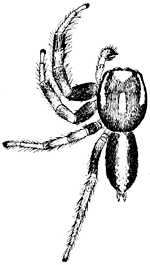
For comparison: An immature and an adult
My verdict: Thyene ogdeni - leighi group cf T. leighi, Leigh's Jumping Spider (immature male)



